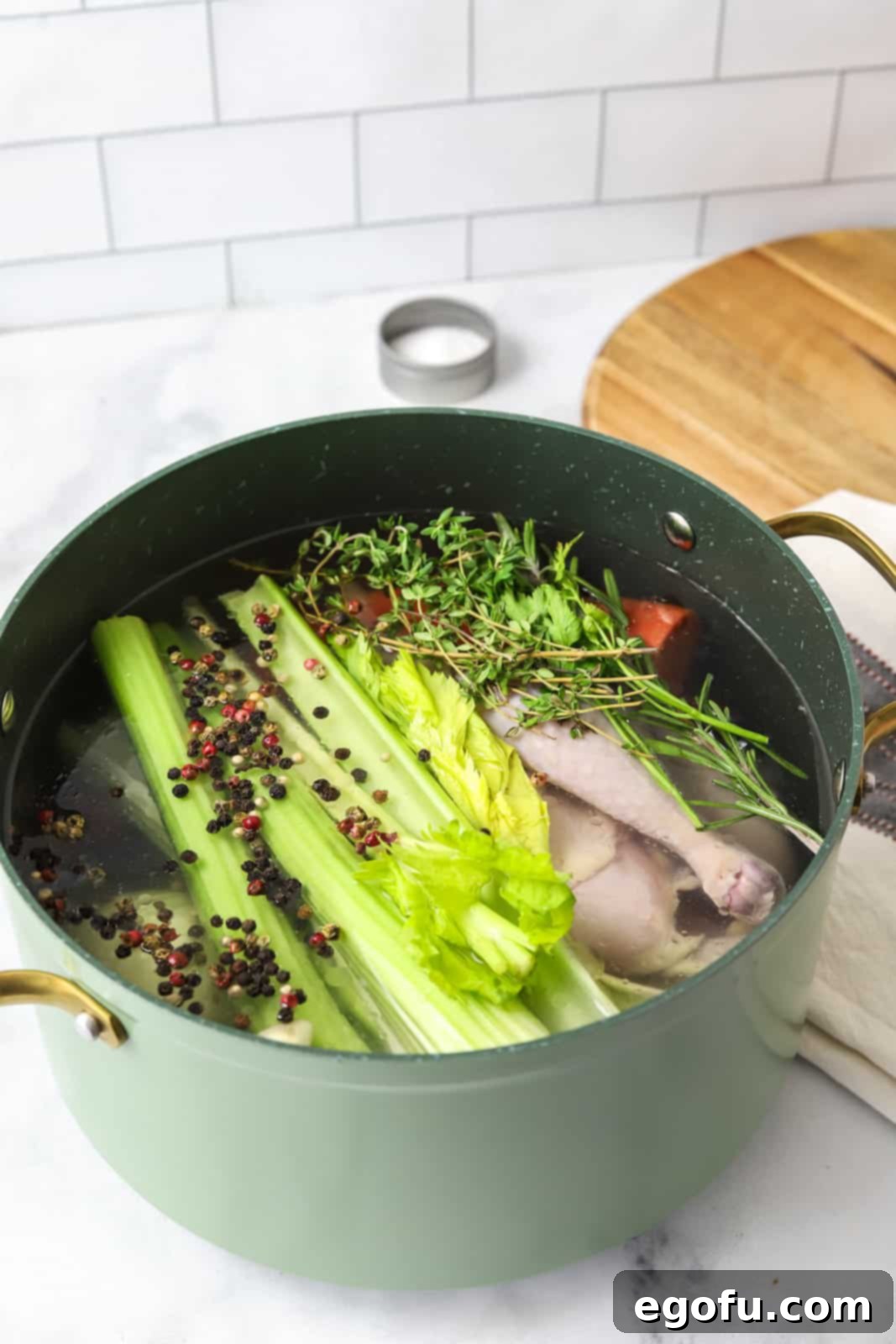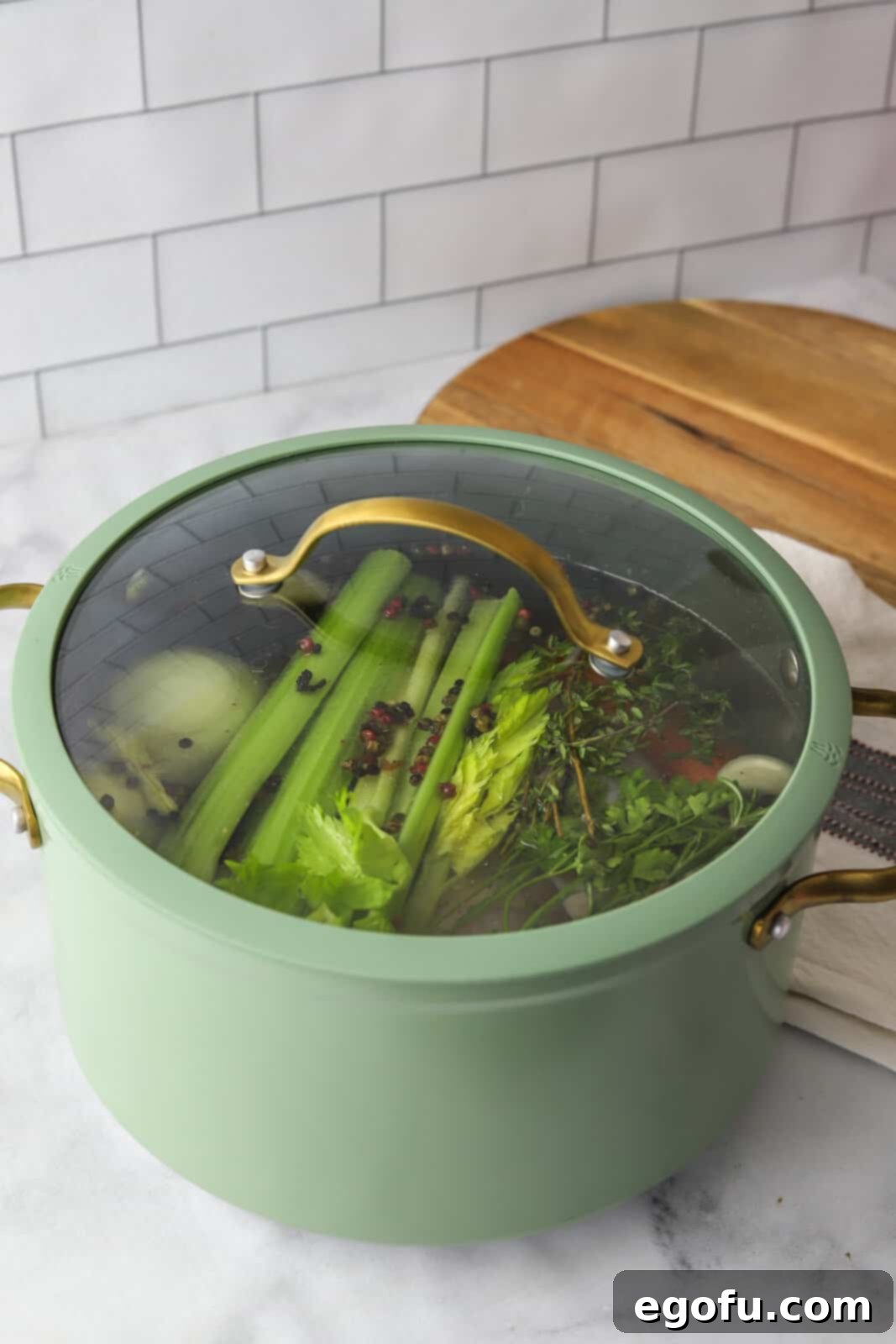Transform your everyday cooking into something extraordinary with this incredibly flavorful Homemade Chicken Broth. Crafted with fresh, simple ingredients, this liquid gold not only elevates the taste of any dish it graces but also infuses it with a wealth of nutrients. Forget bland, store-bought cartons; experience the profound difference that a truly authentic, slow-simmered chicken broth can make in your culinary adventures!
The Unrivaled Benefits of Homemade Chicken Broth
For those who frequently find themselves whipping up hearty soups, stews, or comforting casseroles, mastering the art of homemade chicken broth is an absolute game-changer. It’s a foundational recipe that promises a depth of flavor and nutritional value simply unattainable with commercial alternatives. The process itself is surprisingly straightforward, requiring minimal active effort and yielding immense rewards. Beyond its superior taste, homemade chicken broth is particularly cherished during cold and flu season. There’s nothing quite as soothing or restorative as a steaming bowl of chicken noodle soup, made with your own nourishing broth, when you’re feeling under the weather. During these times, I find myself making large batches regularly, not just for soup, but also utilizing the tender leftover chicken for various other delicious meals like casseroles or salads. The best part? This versatile broth can be easily frozen, ensuring you always have a supply of this culinary essential on hand.

Why Homemade Trumps Store-Bought Every Time
While convenience often dictates our choices, especially in a busy kitchen, the benefits of making your own chicken broth far outweigh the slight investment of time. Store-bought broths, even those labeled “organic” or “low sodium,” often contain unnecessary additives, artificial flavors, and excessive sodium. Homemade broth, on the other hand, gives you complete control over every single ingredient. This means you can tailor the salt content to your exact preference, ensure no preservatives are added, and guarantee a fresh, natural flavor profile that enhances, rather than overwhelms, your dishes. Moreover, the slow simmering process of homemade broth extracts valuable collagen, amino acids, and minerals from the chicken bones and vegetables, providing a truly nourishing foundation for your meals. This nutrient-rich profile is often cited for its potential benefits to gut health, joint support, and immune function, making homemade broth a functional food for wellness.
Frequently Asked Questions About Crafting Your Broth
Absolutely! This recipe is incredibly adaptable and works wonderfully with turkey. If you have leftover bones from a Thanksgiving turkey or any other cooked turkey, they are perfect for creating a rich, flavorful broth. Utilize any remaining meat on the bones, neck bones, or even giblets (excluding the liver, which can make the broth bitter). Simply add all these components to a large stock pot along with the other specified ingredients and follow the instructions as written. The robust flavor locked within turkey bones and residual meat will yield a deeply savory broth.
Yes, making chicken broth in a slow cooker is a fantastic option for hands-off cooking. To do so, combine all the ingredients in a large slow cooker (a 6-quart or larger model is ideal). Set it to cook on low for a minimum of 8 hours, though cooking it for up to 12-24 hours will extract maximum flavor and nutrients. Once simmering is complete, carefully strain the broth and then proceed with the remaining steps of the recipe, such as cooling and storage.
While browning the chicken and vegetables at the beginning is an optional step, it’s one I highly recommend for an added layer of complexity and depth of flavor. This initial sautéing, known as the Maillard reaction, caramelizes the ingredients, creating rich, savory notes that infuse beautifully into the broth. If you’re short on time or prefer a lighter-colored broth, you can certainly skip this step, but for the most robust and deeply flavored broth, a few minutes of browning makes a noticeable difference.
For this chicken broth recipe, I strongly advise using fresh herbs over dried ones. While dried herbs are convenient for many dishes, the vibrant, aromatic essence of fresh rosemary, thyme, and parsley truly makes a significant impact on the overall flavor of the broth. Fresh herbs impart a brighter, more nuanced taste that dried herbs simply cannot replicate in a slow-simmered liquid like broth.
Absolutely! The chicken meat, after simmering in the broth with vegetables and herbs, will be wonderfully tender and infused with flavor. To ensure the meat isn’t overcooked and dried out, you can remove the whole chicken from the pot after about 45 minutes to 1 hour of simmering, once the meat is cooked through and easily falls off the bone. Separate the meat from the bones and set it aside to cool. Then, return the carcass (bones, skin, and any remaining bits) to the pot to continue simmering the broth for the full duration. The cooked chicken meat can then be shredded or diced and used in a myriad of recipes, such as chicken noodle soup, chicken salad, tacos, enchiladas, or various chicken casseroles.
Yes, the amount of salt in this broth is entirely adjustable to your personal taste and dietary needs. This recipe is designed to produce a flavorful broth that isn’t excessively salty, allowing you flexibility. If you are following a low-sodium diet, simply reduce the amount of salt added or omit it entirely during the cooking process. You can always add salt to individual dishes when you use the broth later. This customization is one of the key advantages of preparing your own homemade broth.
The versatility of homemade chicken broth is truly astounding. It serves as a foundational liquid for countless recipes, significantly enhancing their flavor. Some favorite applications include classic comforting soups like Old-Fashioned Chicken and Dumplings, rich and creamy Crock Pot Chicken and Noodles, hearty Chicken and Wild Rice Soup, and spicy Crock Pot White Chicken Chili. Beyond these, it’s excellent for making gravies, sauces, risottos, cooking grains like rice or quinoa, deglazing pans after sautéing meats, and even poaching chicken breasts for salads.
Once your broth has cooled slightly, it can be transferred to airtight containers or mason jars and stored in the refrigerator for up to 4 days. For longer storage, homemade chicken broth freezes beautifully. Ladle the cooled broth into freezer-safe containers or mason jars, leaving about 1/2 to 1 inch of headspace at the top to allow for expansion during freezing. Frozen broth will maintain its quality in the freezer for up to 6 months. To defrost, simply transfer it to the refrigerator overnight or gently thaw it on the stovetop over low heat.
Yes, chicken broth can be safely canned for shelf-stable storage. However, it is crucial to note that chicken broth is a low-acid food, and therefore, it must be processed using a pressure canner. Water bath canning is only suitable for high-acid foods and is not safe for preserving broth. Always follow approved, up-to-date canning procedures from reputable sources like the USDA or your local extension office to ensure food safety. As an alternative to canning, freezing is also an excellent and safe long-term storage method for homemade broth.

Essential Ingredients for a Perfectly Flavorful Broth
Creating a robust and aromatic chicken broth starts with a selection of fresh, high-quality ingredients. Here’s what you’ll need to gather:
- Whole Chicken: A 2-4 pound whole chicken (giblets removed for a cleaner flavor, or kept for extra richness) forms the base, providing essential chicken flavor and nutrients.
- Celery Sticks: Adds a subtle, earthy sweetness and aromatic depth to the broth.
- Carrots: Contributes natural sweetness and a beautiful golden hue.
- Garlic: Infuses the broth with pungent, savory notes that are fundamental to its character.
- Onion: Halved, it offers a foundational sweetness and savory backbone without overpowering other flavors.
- Cooking Oil: A tablespoon of your preferred cooking oil is used to lightly brown the chicken and vegetables, initiating the Maillard reaction for deeper flavor.
- Water: The liquid base, typically 6-8 cups, ensuring all ingredients are submerged.
- Fresh Rosemary: A sprig of fresh rosemary adds a distinct, piney, and slightly peppery aroma.
- Fresh Thyme: Contributes an earthy, minty, and slightly floral essence.
- Fresh Parsley: Brightens the overall flavor with its fresh, clean, and herbaceous notes.
- Bay Leaf: An often-underestimated ingredient, bay leaf adds a subtle, complex, and almost floral aroma that rounds out the broth’s profile.
- Whole Peppercorns: Provides a gentle, warm spice without the harshness of ground pepper.
- Salt: To taste, allowing you complete control over the sodium content of your finished broth.

Crafting Your Homemade Chicken Broth: A Step-by-Step Guide
Follow these detailed steps to create a rich and flavorful chicken broth that will be the cornerstone of your cooking:
Step 1: Brown the Aromatics and Chicken (Optional but Recommended)
In a large, heavy-bottomed stock pot, add 1 tablespoon of cooking oil over medium-high heat. Once the oil is shimmering, carefully place the whole chicken, halved onion, celery stalks, carrots, and garlic cloves into the pot. Sauté and lightly brown the contents for about 6-7 minutes, turning occasionally to ensure even browning. This crucial step develops a deeper, more complex flavor profile for your broth.

Step 2: Add Water and Flavor Enhancers
Pour 6-8 cups of cold water into the pot, ensuring that all the chicken and vegetables are submerged by at least an inch or two. Add the fresh herbs: rosemary, thyme, and parsley sprigs. Toss in the bay leaf and 1 tablespoon of whole peppercorns. Season with 1-2 tablespoons of salt to taste, remembering you can always adjust this later.

Step 3: Simmer to Perfection
Bring the contents of the pot to a rolling boil over high heat. Once boiling, immediately reduce the heat to low, cover the pot tightly with a lid, and let it gently simmer for 2-3 hours. A gentle simmer, rather than a vigorous boil, is key to achieving a clear, flavorful broth. If you wish to remove the chicken meat for other uses, do so after approximately 45-60 minutes, then return the carcass to continue simmering.

Step 4: Final Seasoning and Straining
After the simmering period, remove the lid and taste the broth for flavor. This is your opportunity to add more salt if desired. Remember, it’s easier to add salt than to remove it. Once seasoned to your liking, allow the broth to cool slightly before straining. This step is crucial for achieving a clear broth.

To strain, first carefully remove the large chicken pieces and vegetables from the pot using tongs or a slotted spoon. Then, pour the remaining liquid through a fine-mesh strainer lined with cheesecloth (if you desire a very clear broth) into a large bowl or directly into jars. This will catch any smaller bits of chicken, herbs, and vegetable remnants, ensuring a clean, pure broth. Ladle the strained broth into storage containers or jars, and it’s ready for use or storage.

Maximizing Your Broth: Tips for the Perfect Batch
To ensure your homemade chicken broth is consistently exceptional, consider these additional tips:
- Don’t Over-Boil: A gentle simmer is essential. Rapid boiling can emulsify fats, leading to a cloudy broth, and can also make the broth taste less delicate.
- Skim the Foam: As the broth comes to a simmer, you might see foam rise to the surface. This foam contains impurities. Skim it off with a spoon during the first 30 minutes of simmering for a clearer, cleaner-tasting broth.
- Use Cold Water: Always start with cold water. This allows the impurities to slowly rise to the surface, making them easier to skim, and helps extract more flavor from the ingredients over time.
- Kitchen Scraps are Your Friends: Save vegetable scraps (onion peels, carrot ends, celery tops) in a freezer bag. When you have enough, add them to your broth for extra flavor and to reduce food waste.
- Consider Roasting Bones: If you’re using chicken bones from a previously roasted chicken, you’ll get an even richer, darker broth due to the caramelization of the bones and meat.
- Fat Removal: After the broth cools in the refrigerator, a layer of fat will solidify on top. You can easily spoon this off for a leaner broth, or leave it for added richness and flavor, especially if you plan to use it immediately for a hearty soup.
Looking for More Delicious Recipes to Use Your Broth?
Your homemade chicken broth is an incredible foundation for countless delicious meals. Explore these recipes that truly shine with the depth of flavor only homemade broth can provide:
- Crock Pot Chicken and Noodles
- Stuffed Pepper Soup
- One Pot Chicken Noodle Soup
- Chicken and Drop Dumplings
- Creamy Chicken Noodle Soup
- Crock Pot Vegetable Soup

Homemade Chicken Broth
10 minutes
3 hours
3 hours 10 minutes
12
Brandie Skibinski
Ingredients
- 1 Tablespoon cooking oil
- 2-4 pound whole chicken (you can keep or remove the giblets)
- 4 celery stalks
- 2 carrots, peeled and ends cut off
- 2-3 cloves garlic
- 1 onion, halved
- 6-8 cups water
- 1 sprig of fresh rosemary
- 1 sprig of fresh thyme
- 1 sprig of fresh parsley
- 1 bay leaf
- 1 Tablespoon whole peppercorns
- 1-2 Tablespoons salt (to taste)
Instructions
- In a large stock pot, over medium-high heat, add 1 Tablespoon cooking oil. Then add in 2-4 pound whole chicken, 4 celery stalks, 2 carrots (peeled and ends cut off), 2-3 cloves garlic, and 1 onion (halved). Lightly brown the contents of the pot for 6-7 minutes (this step is optional but adds nice flavor.)
- Add in 6-8 cups water, using enough to cover the contents of the pot by an inch or two.
- Add in 1 sprig of fresh rosemary, 1 sprig of fresh thyme, 1 sprig of fresh parsley, 1 bay leaf, 1 Tablespoon whole peppercorns, and 1-2 Tablespoons salt (this is optional and you can add as little or as much as you like).
- Bring to a boil and cover. Then reduce heat to low and let simmer for 2-3 hours.
- After it has simmered, taste for flavor and add more salt if desired.
- Allow to cool slightly then strain. Remove the chicken and larger vegetables, then pour the broth through a fine mesh strainer (to catch any smaller bits of chicken and herbs) and then ladle into jars.
Notes
- The first step of browning the chicken and vegetables can be skipped if preferred.
- Fresh herbs are highly recommended over dried herbs for the best flavor.
- This broth can also be prepared in a slow cooker. Refer to the FAQ section above for instructions.
- Homemade chicken broth freezes exceptionally well for long-term storage. See the FAQ section above for detailed instructions.
- If your celery and carrots are too long to fit comfortably in your stock pot, feel free to cut them into smaller pieces.
Soup
American
Nutrition
Nutritional Disclaimer
“The Country Cook” is not a dietician or nutritionist, and any nutritional information shared is an estimate. If calorie count and other nutritional values are important to you, we recommend running the ingredients through whichever online nutritional calculator you prefer. Calories and other nutritional values can vary quite a bit depending on which brands were used.
Making homemade chicken broth is an act of culinary love, transforming simple ingredients into a versatile, flavorful, and nutrient-packed liquid gold. It’s a foundational skill that will elevate your cooking, bring deeper flavors to your favorite dishes, and offer a comforting warmth, especially during colder seasons. With this detailed guide, you’re now equipped to create your own batches of this kitchen essential, ensuring your meals are always extraordinary. Happy cooking!
